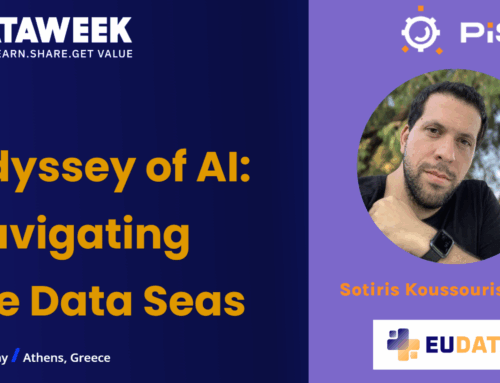Data is Not a Four-letter Word
Data is not a four-letter word. Data is omnipresent. Whether it is information (structured data), knowledge (combined information), experience (used knowledge) or otherwise, and whether it resides between our ears, in libraries, in sensors, in digital wallets, online or other systems and environments. Perhaps that is the reason why the notion of data is so difficult to grasp. Meanwhile, in this Digital Age we are trying to better understand what data is, and how to unlock it, access it, control it, share it, use it, manage it and curate it. Data can be a value and a means. It can be a value and means at the same time, depending on the perspective of the stakeholder. It can even have numerous values and numerous means at the same time, depending on the multiple perspectives of the relevant stakeholders and other dynamics.
So, said otherwise; there is a lot to share, market and exploit.
Dynamics in the Digital Age
At an ever-increasing pace, technology is constantly shaping society along with every other sector of our local, regional, national, and global economies by giving it the impetus needed to accelerate digital transformation and to help address the societal challenges at hand – and to be expected in the mid and longer term -. It also influences our sovereignty, both as individuals, organisations, society, regions, states, alliances, allies and friends, and their respective data.
The technological and related changes are expedited by both non-digital global occurrences such as geopolitical developments and increased and ever-converging technical capabilities such as connected devices, platforms, available data, advanced algorithms and software, computing continuum, high-speed networks and low-latency spectrum and the like.
These enable connecting, inter-connecting and hyper-connecting billions of individuals, organisations, communities, societies and data, with tens of billions of objects, assets, artefacts, systems and services. In short, digital has become a must-have, for people, society and our ecosystems, within the European Union as well as globally. There are a lot of opportunities to explore, develop and grasp.
Meanwhile, for instance considering one of the essential pieces of this n-dimensional and dynamic puzzle, connecting, inter-connecting and hyper-connecting these persons, personas and organisations with the relevant data, devices, systems and services is not an easy feat. Furthermore, Europe’s digital sovereignty is not growing but has been diminished. So, there are a lot of challenges to address and cater for as well. There is a lot at stake.

Europe Fit for the Digital Decade
I want Europe to strive for more by grasping the opportunities from the digital age within safe and ethical boundaries. When talking about the Commissions’ mission called “A Europe Fit for the Digital Age”, President Von der Leyen phrased the importance of the symbiosis between opportunities, risks and ethics.
Obviously, that should generally be nothing new to anyone. However, with the technological and other developments as set forth above, those have outtripped our societal, economical and legal frameworks. Connecting, inter-connecting and even hyper-connecting, and creating new data sharing ecosystems – including data spaces – and other combinatorial possibilities and innovations to empower people and organisations, public and private, and guide Europe’s digital transformation also requires each of us to rethink certain notions about risk and ethics.
In line with the EU Fit for the Digital Age mission, the Commission has developed, made public and started to deliver on the so-called Path to the Digital Decade 2030. It consists of various strategies, common objectives and targets. One of the most notable strategies is the EU Data Strategy.
The EU Data Strategy is aimed to meet the requirements to ethically, securely, trustworthy and conveniently control, share, use and otherwise accountable process EU‘s sensitive personal data and non-personal data as well as sensitive business and public sector data sets, by addressing use cases for all sectors of the economy.
Data, and in particular digital data including digital assets make a crucial cornerstone of the 2030 Digital Decade policy programme. Data is established as a key common denominator. More generally it is linked to the growing concern that the citizens, businesses, and administrations of the Member States are gradually losing control over their data, their capacity for innovation and technological development, their ability to shape and enforce legislation in the digital environment, and access to hardware and software technologies and capabilities. Support has been growing for a new policy approach designed to enhance Europe’s strategic autonomy in the digital field with the objective of protecting the EU values and human rights and strengthening the position of the EU economy.
A few already notable targets of the Digital Decade Policy Programme related thereto are:
- Tech Up-Take: 75% of EU enterprises will use computing services, data or AI.
- Basic Digital Skills: minimum 80% of citizens will have access to a digital identity solution.
- ICT Specialists: 20 million + gender convergence
- Late adopters: more than 90% of SMEs reach at least a basic level of digital intensity
- Innovators: Europe will grow the pipeline of its innovative scale ups and improve access to finance, leading to the number of unicorns doubling.
Said targets are to be met by 2030. The targets are monitored on an annual basis based on the Digital Economy and Society Index (DESI) that summarises indicators on Europe’s digital performance and tracks the progress of EU Member States. The Commission will review the targets by 2026 to take stock of technological, economic and societal developments. The recent Eurobarometer also demonstrates that these are quite essential: “Europeans believe digital technologies will be crucial in their daily lives”.
PISTIS is one of the projects that focuses exactly on that. It aims to deliver a holistic data framework and a reference platform composed of federated deployments for releasing the full potential of the data economy, by renovating the way data is managed, shared and monetised. When combined through an orchestrated architecture, it can accommodate the needs of the core stakeholders engaged and aims to realise the broader concept of the Common European Data Spaces (CEDS) for highly efficient and trustworthy sharing and monetisation of data assets.
Declaration on Digital Rights and Principles
The currently most recommendable, relevant document that both (A) guides each of us in the dimensions of ethics and accountability, and (B) is compact and easy to read as well, however, is the European Declaration on Digital Rights and Principles of December 2022. It is even called EU’s digital DNA.
The Declaration builds on key EU values and freedoms and is aimed to benefit all individuals and organisations, where it is also aimed to provide a guide for policymakers and organisations when dealing with new technologies. It focuses on six key areas:
- Putting people at the centre of the digital transformation;
- Solidarity and inclusion;
- Freedom of choice;
- Participation in digital life;
- Safety and security;
- Sustainability.
Executive Vice-President for a Europe Fit for the Digital Age summarised it as follows: The digital transformation is about ensuring that technologies are safe. That they work in our interests and respect our rights and values. The principles in the declaration of digital rights and principles will continue to be supported by EU legislation.
The Declaration on Digital Rights and Principles, as well as the rights and obligations it contains, have their roots in the core values of the European Union: Lisbon Treaty and its Charter of Fundamental Rights. It further builds on existing digital policies such as personal data protection, privacy, case law of the Court of Justice, and complements the European Pillar of Social Rights. It is truly people-centric by default and is quite essential for the data society and economy within the EU.
Delivering on the EU Data Strategy
The PISTIS project aims to implement the data strategy, as per the aforementioned Declaration on Digital Rights and Principles.
For that, PISTIS for once is aiming to design and develop new technology tools for data marketplaces, in particular in three (3) demonstrator domains: Mobility & Urban Planning, Energy and Automotive. Each demonstrator hub involves multiple organisations working together:
- Mobility & Urban Planning Hub involves organisations from aviation, public transportation, and government agencies. They will test how PISTIS can help them share and trade data.
- Energy Hub focuses on using PISTIS to make the electricity grid more reliable. It will involve companies that produce and distribute electricity, as well as local prosumers (who are both providers and consumers) who generate their own power.
- Automotive Hub looks at how PISTIS can be used to make cars more environmentally friendly, safer, and more efficient. It will involve companies that make cars, traffic authorities and weather data providers.
When any organisation, public or private, small or large, is planning to share data, either inbound or outbound, there are some key notions and recommendations to consider. One of those is reading the European Declaration on Digital Rights and Principles, as well as the Data Strategy. Both are essential yet easy reads. These provide guidance about where the Digital Decade strategies are aiming for, how to benefit from those, how to be part of it, and what main public values, objectives and some other ethical, behavioural, responsibility and accountability components and dimensions are pursued.
The main values and primary principles of the aforementioned Declaration make a lot of sense. However, deploying those and balancing those out (i) in design phase, (ii) pre-procurement phase, (iii) negotiation phase, (iv) implementation phase, (v) operational phase, (vi) in phases of updates, upgrades and continuous improvement, and (vii) before, during and after incidents or (other) accountability events, is complex.
This is also because these and similar values and principles are qualitative and subjective. The ethical interpretation, design, implementation, and related behaviour, (co-)responsibility and (co-)accountability will load and other substantiate these, and related main values, primary principles and other tiered trust components.
Six initial simple yet key validation queries for finding, balancing, establishing and continuously challenging whether the appropriate symbiosis of values and primary principles in particular situations, use cases or scenarios has been achieved, and the right level of continuous appropriate dynamic accountability has been met and can be demonstrated (according to the articles 25 and 32 of the General Data Protection Regulation (GDPR)), are:
- What did one consider, well-beforehand?
- What more did one consider?
- How has these been balanced out with, and to what?
- What did or will one implement?
- How to continuously challenge and improve that?
- Can one demonstrate each of the queries above, and where is that documented?
Throughout each of the various development phases during the PISTIS project, these queries are and will be asked, and the answers discussed, challenged, improved and further and further optimised. This, to deliver on the EU Data Strategy.






